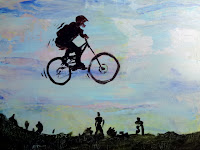“This is the real power of habit: the insight that your habits are what you choose them to be.”
~Charles Duhigg, The Power of Habit
Having recently finished reading The Power of Habit (one of my habits being a habit of listening to audiobooks) it caught my attention this past week when I saw an article about a man who has been writing daily for 52 years, mostly in journals. Near the end of this Wall Street Journal piece was a sidebar on how to build a daily writing habit. The title of Clare Ansberry's January 27 story was 52 Years and Counting: The Power of Daily Writing.
I've been writing daily myself for many decades, with the exception of my most productive "artist years" during college. I often try to help young writers as much as I'm able, and this sidebar was by far one of the most concise set of instructions on how to develop the habit of writing. My definition of a writer is one who writes. If you've had trouble lighting the spark, here's a pretty good regimen to get you going.
How to build a daily writing habit.
One. Write 500 words every day for 28 consecutive days, preferably at the same time and same place, to create a routine.
Two. Don't worry about grammar or punctuation. Be willing to write badly. Authenticity is more important than excellence.
Three. Use prompts to get you going. Make a list of six of the stories you commonly tell. Get a photo and tell the story of that picture.
Four. Keep it private. If you show it to others, you might worry about what they will say and never start.
Five. If you can't think of what to write, describe the room you're in it you are in, what you are wearing, or a room from your childhood home, or what it felt like to brush your teeth.
Six. Carry a notebook to jot down ideas or a recollection, conversation or image.
Sidebar Source: Narrative Journaling: 28 days to writing more or less happily for the rest of your life, a workbook by Charlie Kempthorne.
* * * *
I myself have written a manuscript for parents who homeschool to help them teach writing. The approach I offer is both original and effective. The appendix includes 100 writing prompts. The book is tentatively titled Writing Exercises: How to Teach Writing and Prepare Your Favorite Students for College, Life and Everything Else. If you have suggestions regarding a potential publisher or agent, I'd be most appreciative.
Meantime, if you're a writer, write on.
~Charles Duhigg, The Power of Habit
Having recently finished reading The Power of Habit (one of my habits being a habit of listening to audiobooks) it caught my attention this past week when I saw an article about a man who has been writing daily for 52 years, mostly in journals. Near the end of this Wall Street Journal piece was a sidebar on how to build a daily writing habit. The title of Clare Ansberry's January 27 story was 52 Years and Counting: The Power of Daily Writing.
I've been writing daily myself for many decades, with the exception of my most productive "artist years" during college. I often try to help young writers as much as I'm able, and this sidebar was by far one of the most concise set of instructions on how to develop the habit of writing. My definition of a writer is one who writes. If you've had trouble lighting the spark, here's a pretty good regimen to get you going.
How to build a daily writing habit.
One. Write 500 words every day for 28 consecutive days, preferably at the same time and same place, to create a routine.
Two. Don't worry about grammar or punctuation. Be willing to write badly. Authenticity is more important than excellence.
Three. Use prompts to get you going. Make a list of six of the stories you commonly tell. Get a photo and tell the story of that picture.
Four. Keep it private. If you show it to others, you might worry about what they will say and never start.
Five. If you can't think of what to write, describe the room you're in it you are in, what you are wearing, or a room from your childhood home, or what it felt like to brush your teeth.
Six. Carry a notebook to jot down ideas or a recollection, conversation or image.
Sidebar Source: Narrative Journaling: 28 days to writing more or less happily for the rest of your life, a workbook by Charlie Kempthorne.
* * * *
I myself have written a manuscript for parents who homeschool to help them teach writing. The approach I offer is both original and effective. The appendix includes 100 writing prompts. The book is tentatively titled Writing Exercises: How to Teach Writing and Prepare Your Favorite Students for College, Life and Everything Else. If you have suggestions regarding a potential publisher or agent, I'd be most appreciative.
Meantime, if you're a writer, write on.


















































